|
Global Automotive Management Council
3rd Course: Global Automotive Technology Senior Management Briefing May 1999, Stockholm Title: Globalization’s Impact on Manufacturing: Bodies-in-White and Airbags as Case Study Examples Jeff R. Dieffenbach dieffenbach@alum.mit.edu | deepbrook.com | deepbrook.com/writing IBIS Associates www.ibisassociates.com |
|
|
ABSTRACT
Globalization increasingly exerts a strong competitive and even deflationary force on products and services. With respect to manufacturing, the automotive industry must avail itself of the advantages of globalization to offset this competitive force. This paper uses two case studies--body structures and airbags--to examine materials and manufacturing decision-making in the context of globalization. Three primary findings emerge. One, globalization extends beyond the duplication of local products to saturate global markets; it must distribute global best practices for the benefit of local markets. Two, manufacturing reacts weakly to globalization where other aspects of technology--as well as economic and political elements--thrive on and even drive it. Three, the key to formulating a global manufacturing strategy lies in understanding where to commonize and where to differentiate, and whether to attempt either in the face of varying levels of entry barriers. |
|
|
INTRODUCTION
The electronics industry repeatedly asserts an argument along the following lines: if the automotive industry innovated at the same rate as electronics have, people would be driving Rolls Royces (or other fine automobiles!) capable of traveling thousands of kilometers per hour, with a mass of several kilograms, at a pricetag of only tens of Euros. Ignore for the moment that this industry’s idea of safety suffers “crashes” several times a day in the course of “normal” operation. In reality, of course, the automobile and electronics differ quite markedly. Electronics carry information, an entity with essentially no size and certainly no blood. Continued miniaturization follows the inevitable quest for faster speeds, greater functionality, and longer battery lives. The automobile, on the other hand, must continue to convey our families, and safely at that. Moore’s Law, which continues to predict the doubling of transistor capacity and the halving of transistor cost every eighteen months, does not apply to the transportation of human beings. While the price of electronics continues to spiral down per unit of function, the price of automobiles continues to climb … sometimes slowly, sometimes not. How does globalization come into play? Where information technologies hide profits in the growing gap between falling prices and much more rapidly falling costs, manufacturing technologies are unable to follow suit for reasons of physics and mechanics. With respect to manufacturing, the automotive industry must avail itself of the advantages of globalization to offset its competitive force. To take advantage of globalization, it is necessary first to define it. |
|
|
What is globalization?
Thomas L. Friedman, in his neoclassic treatise on globalization entitled The Lexus and the Olive Tree, explains that globalization has replaced the Cold War system to become “… the dominant international system at the end of the twentieth century [1].” Others argue that globalization’s presence extends farther back in time. Martin Khor, Director at the Third World Network, an independent network of non-profit organizations with a focus on developing nations, concisely defines globalization as “… what we in the Third World have for several centuries called colonization [2].” His assessment contains more truth than many might be comfortable admitting. In fact, it is quite natural to view globalization at least in part from a local perspective: “How can I convince the world to buy more of what I do where I am now, the way that I do it now?” In reality, of course, globalization must extend beyond the duplication of local products to saturate global markets; it must deploy global best practices for the benefit of local markets. According to Lubbers, globalization results from three prime movers: political, economic, and technological [2]. All technology is not created equal, however. Information and telecommunications technologies, for instance, drive globalization; manufacturing reacts to it. Globalization in the context of manufacturing might be defined, then, as the deployment of global best practices in order to increase the ratio of output to input. Note that globalization might, but also might not, suggest the addition of locations outside of a current region. Inputs might be: more powerful purchasing dynamics; improved or even new processes; increased labor efficiencies; centralized research, development, and engineering; or simply added capacity. Outputs might be: improved manufacturing yields and productivity; increased overall production levels; or simply reduced costs. Delta value bests delta cost. Globalization for globalization’s sake, though, is dangerous. “Failure to define the reasons for globalization will lead to ineffective, counterproductive realignment of the corporation [3].” |
|
|
Why globalize?
Two central reasons to pursue globalization dominate the playing field.
|
|
|
How has globalization affected automotive manufacturing?
Dicken concisely outlines globalization’s macro impact on automotive manufacturing [5]. Open spaces and inexpensive fuel resulted in the North American market for larger automobiles diverging from the markets for smaller cars in Europe and Japan (these three markets together account for on the order of two-thirds of global vehicle consumption [6]). The two oil crises in the 1970s narrowed the design gap considerably. Dicken elaborates.
Economic differences begin to disappear as well. “The importance of geographical differences in labour costs is, however, declining as the industry becomes more capital intensive.” Dickens continues by observing what was appearing to be a split towards either world car or luxury niche car production. Instead, “glocalization” emerged: body assembly, paint, and final assembly performed in the region of sale. This result should not be surprising. There is no cost-driven need to manufacture millions of units at a central site for distribution around the globe. Economies of scale for automotive manufacturing fit demand on the part of most national markets: tens to hundreds of thousands of components or vehicles per year. The remainder of this paper examines two case studies--body structures and airbags--to consider materials and manufacturing decision-making in the context of globalization. The paper concludes by summarizing the key lessons learned. |
|
|
CASE STUDIES
Body structures The combination of body structure and exterior panel set that makes up an automotive “body-in-white” (BIW) accounts for more than 20% of the mass of a typical passenger vehicle. The vast majority of autobodies--on the order of 99.95%!--are stamped and spot welded from sheet steel. Driven primarily by demands for mass reduction, aluminum and polymer composite variations on the conventional BIW repeatedly challenge steel. To date, only one architecture, the Audi A8 aluminum, has made any inroad of note. This inroad is small, however, on the order of 15,000 vehicles per year out of more than 50 million worldwide. By far the predominant reason that lightweight alternatives to steel have not found market success has been and continues to be cost. There are several reasons to be somewhat optimistic about alternative BIW technologies. First, environmental pressures to reduce mass in order to decrease fuel consumption and emissions continues to grow; the cost gap may be outweighed by other factors. Second, as alternative technologies climb the learning curve, they tend to come down in cost; the cost gap is not static as a function of time and development effort. Third, different annual production volumes favor the alternative technologies differently; the cost gap is a function of output. In addition to ascertaining how these different factors affect the competitive position of the various technologies, it is critical to understand how manufacturing globalization changes the landscape as well. This paper considers a midsize, four-door sedan with North American body fabrication and assembly to explore the impact of globalization on body architecture. Four generic material systems are selected as case studies from among an almost infinite number of design, material, and process alternatives.

Figure 2 shows how these designs translate to manufacturing cost per body (y-axis) as a function of annual production volume (x-axis) [7]. Manufacturing cost, arrived at via Technical Cost Modeling [8], includes the following elements and operations.
At lower volumes, costs are driven by the relative amount of investment. In general, products with larger investments will have higher costs than those with smaller investments. At higher volumes, material price is a stronger driver, such that the product with the lower material cost will tend to be favored. The overall drop in cost from low to high volume is a function of the process throughput. The faster the production rate, the greater the drop. The classic example of an interesting cost-volume curve is for a steel stamping versus a molded plastic part. Steel stamping is characterized by higher investment cost, lower material cost, and faster production rate. Conversely, molded plastic has a lower investment cost, higher material cost, and slower production rate. As a result, plastics do well based on cost for lower volumes while steel does better at higher volumes. 
With respect to Figure 2, at very low annual production volumes--below 20,000 vehicles per year--the polymer composite BIW demonstrates the lowest manufacturing cost. From this level up to about 50,000 vehicles per year, the aluminum spaceframe takes over. Above 50,000, the steel unibody shows the lowest manufacturing cost. The aluminum unibody is never the low cost alternative. How do these production levels map to trends in manufacturing? The distinction must first be made between “platforms” and “models.” Simply put, a platform is the backbone of a vehicle, and can be shared across two or more models with distinct personalities.
Overall, the “few platforms/many models” trend suggests that structures (which drive the platform) should be those that are cost effective at high volumes (the steel unibody), while panels (affecting model differentiation) will ultimately evolve towards those that do well at lower volumes (plastics). For alternative approaches such as the aluminum spaceframe or the composite monocoque, then, success beyond a few low volume niche vehicles will be predicated on increasing their low cost domains to higher and higher volumes. Before concluding this examination of bodies-in-white, several recent developments are worth considering. In all of these cases, of course, it is critical to note the proven success of the current steel unibody, the uncertainty in the high volume cost- and technology-effectiveness of new approaches, and the difficulty of introducing them even in the best of scenarios. ULSAB: The Ultra Light Steel Auto Body consortium (ULSAB) formed several years ago in response to the Partnership for a New Generation of Vehicles (PNGV). PNGV, a government-industry initiative in the United States, aims to increase passenger vehicle fuel economy without increasing cost or sacrificing other elements of vehicle performance. Phase I and II of the ULSAB program succeeded in developing “demonstration hardware” bodies-in-white with a mass reduction of 20% relative to their benchmark “future” vehicle. Much of this success hinged on the successful workings of a globally focused consortium of 35 international steelmakers. The effort resulted in an effective “raising of the bar” for challenging material systems. Audi A8: As previously introduced, the Audi A8’s aluminum spaceframe represents the second highest body architecture following the steel unibody. While the birth of the A8 has at many times been difficult, its learning curve has been greatly compressed compared with the development of the steel unibody. Audi appears to remain committed to the aluminum spaceframe concept, with the anticipated introduction of the Al2 at volumes in the 50,000 to 75,000 vehicles per year range and a third generation design reportedly on the drawing boards. Given that the aluminum spaceframe competes best at lower production volumes, the global platform-model trend increases the challenge for this architecture. Autokinetics: Autokinetics, a design firm based in Rochester Hills, MI, also embraces the spaceframe approach, but in stainless steel. Preliminary analyses of their efforts show significant mass AND cost savings potential versus the steel unibody. Mass is projected to be on the order of 50% of a conventional steel unibody, with a cost savings at all volumes of an estimated 20% to 40% through body fabrication, body assembly, and paint. In this case, the global platform-model trend favors increased adoption. Carbon fiber: Carbon fiber based polymer composites have long been touted as the future of the auto body. Today, this future remains a good way in the distance for mainstream passenger vehicles. The composite monocoque in glass is not a particularly appealing solution. Its mass reduction fails to match that of aluminum, and its cost is high except at the lowest (and most uninteresting) production volumes. The introduction of carbon fiber would certainly improve the mass position, yielding a design on the order of 40% to 50% of the mass of today’s steel unibody. From a cost standpoint, however, the comparison gets worse, not better. Substituting inexpensive carbon ($11.00/kg, or $5/lb) for glass and assuming order of magnitude process speed improvements still results in a more expensive body compared with the glass-based design. Global sources of carbon fiber may allow prices to reach this low level, but offer little else in the way of promise. Chrysler ESX2: The Chrysler CCV and ESX2 are concept vehicles that employ large injection molded, glass reinforced plastic upper body structure/exterior parts mounted on a metal frame (steel in the case of the lower-end CCV, aluminum for the PNGV-prompted ESX2). According to DaimlerChrysler, this approach promises a 20% cost savings at 100,000 vehicles per year. Not only are the CCV and ESX2 globally inspired (the original CCV was initiated with developing countries in mind), as plastic-metal hybrids, they fit well with the global platform-model trend. Summarizing for the body-in-white, globalization and the few platforms/many models trend have and will continue to impact body-in-white manufacturing, albeit not strongly, helping some technologies while hindering others.
|
|
|
Airbags
IBIS examined the global airbag supply chain to understand where decisions were made concerning the selection of the nylon that makes up the bag itself [9]. Drawing on this understanding, recommendations were then made as to how best to continue and grow the supply of nylon in airbag systems. Figure 3 graphically presents the airbag supply chain for North America in 1995 from the perspective of nylon supply. The “tiers” of this supply chain are as follows.

Figure 3 also shows many of the major players at the time. Each “racetrack” curve represents an individual company. Parallel diagrams were developed for Europe, Japan, and Korea. Drawing on an extensive round of interviews that led to the creation of these diagrams, trends were projected for a number of topics as a function of global region.
Summarizing for airbags, it was observed that the complexity of airbag supply chains was greatest in North America, followed closely by Europe, more distantly by Japan, and most distantly by Korea. For a nylon supplier with production capabilities in North America and/or Europe, those two markets were essentially the same. The lack of nylon production in Japan effectively barred a direct presence in that region; nylon would be supplied only in the limited form of complete airbag modules imported into the country as a finished good. The absence of any airbag manufacturing in Korea implied that all airbag modules would be imported, and therefore that nylon supply in the country was not an issue. Again, and not surprisingly, globalization has an impact on decision-making affecting manufacturing. |
|
|
CONCLUSION
It is clearly no longer possible to think of manufacturing except in a broad global context. Taking a global perspective will allow automotive industry participants to maximize manufacturing gains; a failure to focus globally will ensure manufacturing losses. The key to formulating a global manufacturing strategy is to understand where to commonize and where to differentiate. In the automotive industry, the answer is to commonize on platforms and differentiate with models. Respecting commonization and differentiation is not sufficient for successful manufacturing decision-making, however. Almost by definition, in today’s business climate, globalization implies expansion. And expansion must always be considered in the context of barriers to entry.
|
|
|
REFERENCES
[1] Thomas L. Friedman, The Lexus and the Olive Tree, Farrar, Strauss, and Giroux, April 1999. back [2] R.F.M. Lubbers, Globalization Studies, http://www.globalize.org, May 1999. back [3] Ashok B. Boghani, “Managing automotive technology,” Automotive Engineering International, November 1998. back [4] Automotive M&A Review: Industry Insights and Trends, “Large Deals Drive Record Automotive M&A Activity,” Bowles Hollowell Conner, http://www.firstunion.com/business/capmarkets/bhc, April 1999. back [5] Peter Dicken, “’Wheels of change’: the automobile industry,” Global Shift: Transforming the World Economy, The Guilford Press, New York, 1998. back [6] World Auto Atlas and Directory, Ward’s Communications (Southfield MI, USA) and Pemberton Associates (Oxfordshire, England), 1998. back [7] Jeff R. Dieffenbach. “Challenging Today's Stamped Steel Unibody: Assessing Prospects For Steel, Aluminum, And Polymer Composites,” International Body Engineering Conference, 1997. back [8] John V. Busch, Technical Cost Modeling of Plastics Fabrication Processes, Ph.D. Thesis, Massachusetts Institute of Technology, Cambridge MA, 1987. back |